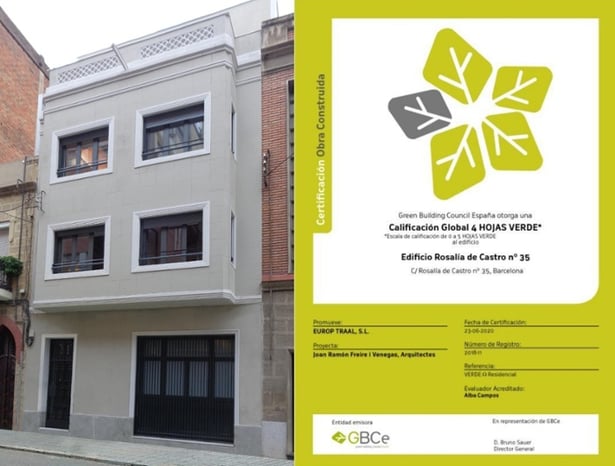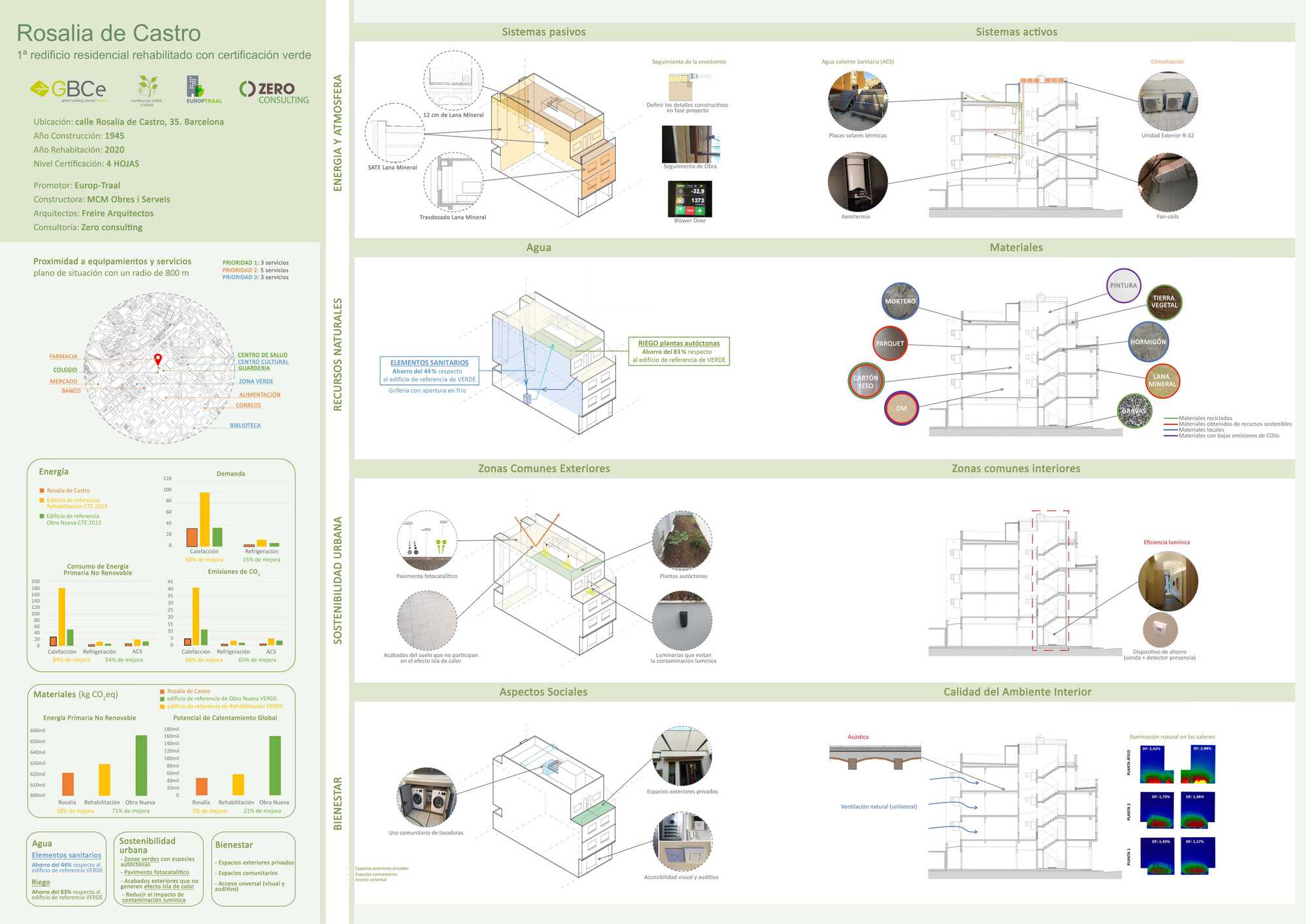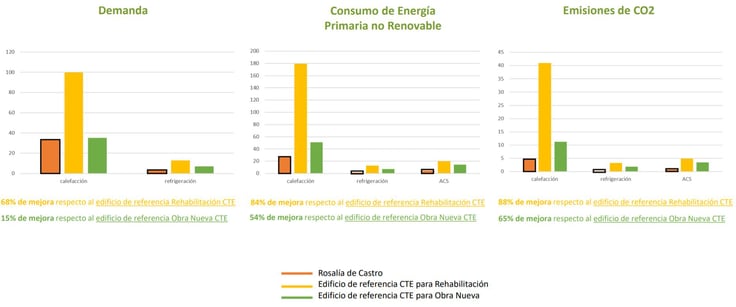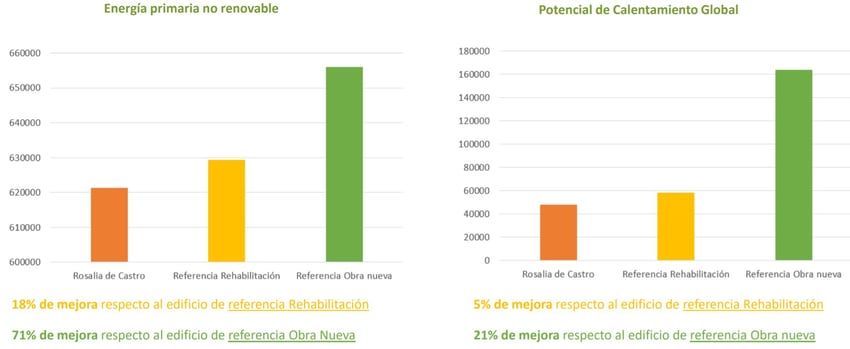In this article, we present the first residential building retrofitted with 4-leaf VERDE certification, as an example of energy retrofitting project in urban areas.
Why should we be interested in building rehabilitation?
The years go by and for the buildings, too. And although the majority of our current real estate is considered young, there are several factors that promote its rehabilitation. In recent years, there has been a notable growth in retrofitting activity, representing 55.7% of the total turnover of the building industry in 2018 and exceeding the turnover of new construction for the third consecutive year(ERESEE 2020).
The reasons are not few. The EU's European Green Deal policies call for a decarbonisation of the sector by 2050, the large environmental footprint of construction, the spatial constraint on existing urban stock, and the recent state investment for the energy retrofitting of buildings indicate that building retrofitting will be one of the key factors for the future of Europe's real estate stock.
-1-1.jpeg?width=800&name=Fotos%20Linkedin%20-%20Setembre%20(5)-1-1.jpeg)
Sustainability associated with building rehabilitation
In terms of sustainability, energy retrofitting has several advantages over new construction: it promotes the spatial, material and heritage conservation of the urban fabric; it improves the energy performance of existing buildings and represents an economic saving in the energy consumption of housing for both the developer and the end user.
At a regulatory level, the Basic Document on Energy Saving of the CTE describes the mandatory energy saving interventions to be carried out in new construction buildings and in existing buildings.
That said, which type of construction is more sustainable: energy retrofitting or new construction? Is the new CTE 2019 strict enough in the promotion of sustainable housing?
It is evident that each project is different and that it is not possible to obtain a firm answer in this regard. We can build very well and rehabilitate very badly, or vice versa. What we do observe is that the requirements of the CTE 2013 are not strict enough for the promotion of sustainable building.
Case study: Rosalía de Castro
It is a building from the year 1945, located in Barcelona and managed by the property of Europ-Traal. Due to maintenance, investment and environmental responsibility reasons, Europ-Traal decided to go for a comprehensive building rehabilitation and to certify it with a sustainability certification tool, namely VERDE.

The sustainability strategy consists of:
- To study the energy performance of the building as a whole by means of an energy simulation
- Reduce energy demand through passive system design
- Optimising the building's energy consumption by applying low carbon technologies
- Achieve the highest GREEN score
The VERDE tool (Building Reference Efficiency Assessment) calculates the final result of the certification as a weighting of the reduced impacts compared to a baseline building defined with the minimum requirements of the applicable CTE, in this case, the CTE 2013.
Given this process, and as a consulting firm specialising in the sustainability of buildings, we found it interesting to compare the minimum energy requirements demanded by the CTE 2013, both in new buildings and in renovations, with the results of the VERDE sustainability certification process.
What do we observe?
.jpeg?width=300&name=Fotos%20Linkedin%20-%20Setembre%20(6).jpeg)
- The application of the VERDE requirements significantly improves the energy performance of the building with respect to those required by the CTE 2013 in both new buildings and renovations.
- In relation to energy demand, consumption and carbon emissions associated with energy, it can be seen that the baseline building for new buildings in the CTE 2013 is more demanding than the baseline building for refurbishment in the CTE 2013.
- Although neither the CTE 2013 nor 2019 requires a Life Cycle Analysis to be carried out, the VERDE tool does. And the reference buildings that the sustainability certification compares are based on traditional Spanish construction solutions. The comparison shows that the construction details proposed for refurbishment have a smaller environmental footprint than those for new construction.
Below, we detail the interventions to reduce the overall energy demand and to minimise the environmental footprint of the building.
Interventions for the reduction of energy demand

Action on the existing envelope
An improvement in insulation is proposed depending on the orientation of the facades (increase in the roof, EIFS system on the dividing facade and wall cladding on the main facade). Its correct implementation is monitored throughout the rehabilitation process. Although the building does not require it, two Blower Door tests are carried out, one for each type of dwelling.
Installation of energy savings and low pollution devices
Presence detectors and lighting probes are installed, as well as outdoor luminaires that do not generate light pollution.
Study of the energy performance of exterior materials
Replacement of exterior finishes with clear photocatalytic flooring that does not contribute to the heat island effect.
Installation of active systems of low-carbon technologies:
Incorporation of renewable energy systems consisting of solar thermal panels and aerothermal energy, with R32 refrigerants that are more environmentally friendly and efficient. Start-up to check its proper functioning.
Study of natural lighting
The integration of natural lighting with artificial lighting design ensures reduced energy consumption in the building. However, its study is usually complex in building retrofitting due to the existing geometry of the building. In this case, it was not possible to meet the requirements of the VERDE certification due to the defined volumetric characteristics of the building in question.
Water
Incorporation of cold-opening taps, reuse of rainwater for irrigation of native plants and installation of low-flow toilets.
Materials
Use of local materials, obtained from natural resources, recycled or with low VOC emissions.
Once these passive measures are applied, what do these energy interventions represent in comparison to the requirements of the CTE?
Results after the interventions

It is observed that, compared to the baseline building retrofit defined by the CTE, energy retrofitting buildings with VERDE criteria represents:
- A 68% reduction in total heating and cooling demand
- Total non-renewable primary energy consumption in heating, cooling and DHW consumption is minimised by 84%
- An 88% improvement of the associated CO₂ emissions
If we compare it with the baseline building for new buildings as defined by the CTE 2013, retrofitting with VERDE criteria represents:
- A 15% reduction in total heating and cooling demand
- A 54% improvement in total non-renewable primary energy consumption in heating, cooling and DHW consumption
- A 65% improvement in associated CO₂ emissions
As mentioned above, the CTE (2013, nor the new 2019 version) does not contemplate the calculation of the environmental footprint of the building, so it is not mandatory to perform a life cycle analysis of the building. VERDE, on the other hand, requires its study and compares its results with baseline buildings based on common construction details of the Spanish building stock.
If we translate the results of the interventions in kg CO₂ equivalent emissions, we observe that the emissions of the Rosalia building compared to the VERDE baseline building rehabilitation:

- Emissions from non-renewable primary energy are reduced by 18%
- Global Warming Potential (GWP) is reduced by 5%
And in the case of comparing it with the new construction building defined by VERDE:
- Emissions from non-renewable primary energy are reduced by 71%
- Global Warming Potential (GWP) is reduced by 21%
Conclusions
As we indicated at the beginning of the article, there is no exact rule when calculating the sustainability of a building. Each project is different, and its interaction with the environment will depend on the will of its owner and user, its location, geometry, design, and operation.
Even so, state regulations help promote interventions to improve the energy performance of buildings and reduce their environmental footprint. However, it seems that the demand for sustainability has not been sufficient so far. A recent study indicates that around 75% of the real estate stock in the European Union is considered energetically inefficient.
We will see in the coming years if the requirement for a 40% savings in non-renewable primary energy use dictated by the new CTE 2019 improves the urban environmental impact.

-1-1.jpeg)
